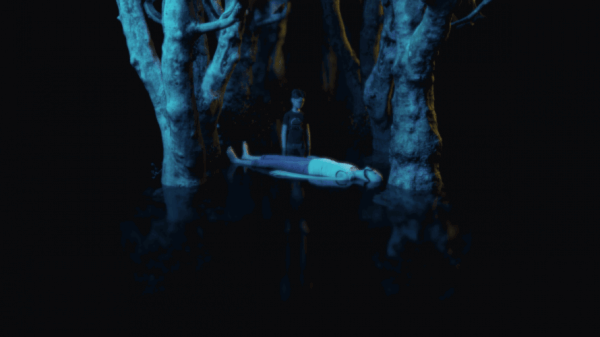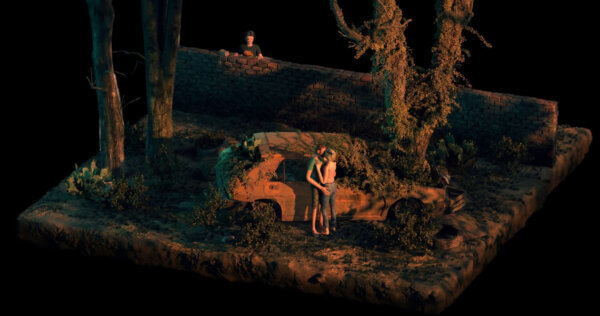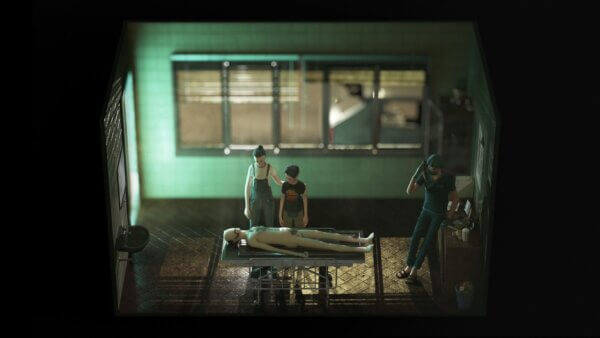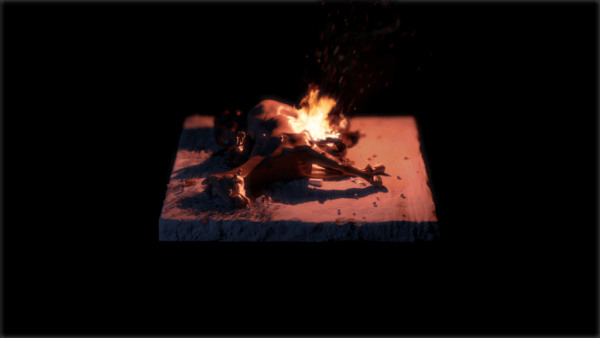Interview with Pulsión (Drive) director Pedro Casavecchia
Nestled in a run-down superb stands a dirty, forgotten house; inside lives an unusual young man. Harsh circumstances, unkind realties and torturous mental health problems sink him deeper and deeper into a grim, hallucinatory world of his own making. Pulsión, or Drive in English, explores the mind and evolution of a would-be killer. A story of sorrow and gruesome visons, told by the talented visual effects artist-turned-writer/director Pedro Casavecchia, the film explores how feeling trapped in all aspects of life can fuel one juvenile delinquent’s descent into mania and depravity.
As Pedro’s first fully-fledged foray into short film creation, he took it upon himself to create all aspects of this stunning, stylistic thriller. Choosing to sit the audience on the outside looking in, the film feels simultaneously voyeuristic and intimate. Like watching an insect suffer on hot concreate, we pass wordless judgement on the curiously cruel vacuum that defines the central character’s life. The film seems to comment on not only its subject but on our culture’s never-ending obsession with true crime, our desire to unpick and unravel the whys, whats and hows of the criminally insane – or the criminally forgotten. Although the film seeks to explore what drives someone to commit such heinous and unforgivable crimes, in a way we too are being asked why we want to watch it all unravel.
Beautifully rendered, with juxtaposing lighting choices, immensely-detailed environments and the unique use of almost miniaturesque perspective. The film creates a series of perfect tableaus detailing the events that lead to the undoing of this nameless but somehow familiar character. We were able to get some time with Pedro to talk about his film and the lengthy process that led to its fruitful and ongoing festival run.
So, I understand you are predominately a visual effects animator. You’ve worked on some incredible projects. Could you start by telling me a little bit about yourself and how you came to work in animation?
I am a 3D artist generalist. I wouldn’t really call myself an animator; I did all the animation in the film but what I do professionally is environments. So, I create scenarios for CG or extensions of scenarios, the company I work for works on live-action films, so they’re more realistic. I have been doing 3D in general for over 12 years. I did a bit of everything in South America where the companies are very small. So you must be flexible because you are one of maybe five people in the team. You’re always active and that’s how I learned most of the skills, by working on small projects and adding one skill at a time very slowly. Then I decided that I should just put all of that into practice and do a film.
Was Pulsión your first film then?
Yeah. I did some tests and stuff. I wouldn’t call them like proper films. This is the first time I really tried to make a whole story, so I would say it’s my first film, yes.
Where did the idea come from?
I have a lot of projects that I never finished because I was just trying to do something. I felt the best way to really continue working on a film over time – because it takes so much when you’re doing it independently – was to work on something that I found interesting myself. At the time I was watching all these true crime documentaries and I found them very interesting and not overly explored; of course it is explored, but less on the reasons of how these characters come to exist. Like, where do these monsters, these killers come from? I started researching and found a lot of them had very abusive childhoods, or mental illness on top of a mixture of terrible things that happened to them. I found the idea of telling the story of a killer, not justifying it, just trying to see how the pieces fit together for them to do what they do, for this character to do what he does, just interesting. So that that was the main idea, to explore these things that I found interesting myself. That’s why I chose this topic.
I’ve seen this film categorised differently, both by yourself and by festivals, as a thriller and a horror. Where do you think it lies?
I would say it is more of a psychological thriller, because as far as I understand, a psychological thriller tells the story through the perspective of the character, which is a very fragmented reality. You can get confused about what’s real and what’s not, because he’s confused about those things. I don’t think it’s a horror film because it’s not focused on the act of killing or all the gore. There are elements maybe of that, but it’s not the most important part. I would say it is more about his mind than what he does.

Pulsión (Pedro Casavecchia/Atlas V)
There are also some surreal elements as well. What is it about animation, in particular CG animation, that you felt aided that kind of hybrid narrative in your film?
I chose the medium mainly because it’s what I know how to do and it’s what I have experience with. I was looking for a job in industry, so I was trying to do something where I could show off what I can do, which is why I chose animation. In the end it was very cool, because it really allows you to do whatever you want. I think I ended up with this aesthetic of little scenarios that is not only, in my opinion, quite a different way to tell a story but also has an impact on the characters, who feel like they are trapped. Even if they are physically outside the house, they remain in this reduced space that they can’t escape from. So that’s something that you could do in live action but would be so much more complicated and expensive. Also, I feel that the fact that it is an animation allows you to go much deeper and be much more explicit without it being too much for the spectator. If you saw this character doing all the things he does and the things that happens to them maybe it would be too much to watch. I didn’t want it to be torture, I wanted it to be something that you wanted to understand better, understand why the characters did what they did, instead of simply judging him. So, I hope it’s not much to endure. In that sense it really helps that it’s animated.
So, in that regard is that where the idea of creating these mini dioramas came from?
I was really locked on to this tilt-shift effect, that makes everything look like a miniature and because I really liked that look on images, I wanted to somehow use it on my film. Then I needed to reduce the render times as much as I could, because every image needs to be processed for a very long time and I was working on a laptop (I did all the film on my laptop at home). So I made sure of that, plus what I was saying earlier about how the character is feeling, how I wanted to convey this feeling of being trapped in their environment. All of that came together and ended up in this diorama. It also really helped me to focus all the details on to a very small space. I wanted to design something that I could do on my own because I didn’t have a team or money or anything. Then I decided it was perhaps a good idea to try and reduce as much as I could and, as a bonus, I think it gave me a different look.

Pulsión (Pedro Casavecchia/Atlas V)
As an aside, I don’t know if you’ve ever heard of the nutshell studies of unexplained deaths? They were miniature dioramas that were created by this woman (Frances Glessner Lee), which showed the layout of a death scenes. They were used in lectures about crime scene investigation. I was just wondering if you’d ever come across them because there’s somewhat a parallel with your film.
I haven’t. I wish I knew about it at the time, but no, I haven’t seen these things in particular, I’ve seen other things like it, but I didn’t know it was to train police officers. But this is really cool, I wish I knew.
Lighting is also a really vital element in the film it both sets the tone throughout but also reveals a lot of the inner conflict of the character and pushes the narrative along as well. What was your approach to the lighting?
I really wanted to use it to guide the viewer, showing the things I wanted you to see because the shots are very small, and full of things. Without very defined lighting if you miss maybe one scene, you might not get something later on, so every scene was kind of important. I wanted it to be something that really guides the eye. If I used a sun ray, for example, I’d make it go through a window so it only hits the character. I also wanted to use it to show this fragmentation of the real, make the lighting go crazier as the character goes crazier. So, in the beginning there was more natural lighting and then later the colours of the light become crazier and from more miscellaneous sources. I used it to show how the character was feeling or perceiving reality.
Towards the end the lighting is reminiscent of older Giallo films like the original Suspiria as it become more acidic and bolder.
Yeah, it becomes quite crazy and colourful. I also wanted it to look nice, so I used this as an excuse to do whatever I wanted and put lights coming from anywhere in whatever colour. There is a shot where just the fridge is open, but there’s a huge light coming out of it, lighting up the whole kitchen. In reality that would never happen, but I took some poetic license. Which is another thing about animation. You can do those things and it’s not wrong because you don’t want it to be real. You just want it to be animation.

Pulsión (Pedro Casavecchia/Atlas V)
On that point, the level of detail in the film is incredible. I understand you used photo scans from real environments sometimes and put them into the CG environment. Could you tell me how you did this? And what do you feel this brought to tangibility of the CG environments?
I used some photo scans, mostly for nature elements such trees because it’s just so hard to get a tree right. Basically, the technique of photo scanning is you go out, preferably on a cloudy day so you have a more diffuse light, as you can re-light your model and that will make it look natural. You just take a lot of pictures of the object, around it, closer and further away and then you just process that, and it creates a 3D model, with the textures printed in.
So, it’s great for natural elements, still objects such as a tree trunk. But for everything else I did hundreds of models for this film. I feel it’s a great way to add realism when your eye keeps jumping around. You don’t really stop to analyse each part, so it really helps having a lot of things. I wanted to really use the environments to tell the story of the characters, to show how they live, to show the things they do. Then I needed all of this clutter because it’s very common for people with mental illness to live in very dirty places. I wanted to convey that they had this miserable life, a poor life and that they didn’t really care at all about the things they had. I needed all of these things to really show their lifestyle and the universe they inhabit; it was necessary to use the environments as characters as well.
Could you tell me a little bit about the production in general, what was the situation that allowed you to make the film, both financially and time-wise?
I used to wake up at 7am and work before my day job started, then after I finished I would work a bit more. There was no budget, no anything. My producers helped more to distribute the film and to put it into festivals. It just took a lot of time and brute force!
The film has picked up some awards amongst which was the Jury prize at Annecy. What was that like? And what has the festival circuit been like with the film?
It started in Annecy where I got the Special Jury mention. After that it really changed, because I finished it in order to send it to Annecy. They accepted it and then I won the award, so from that point on, everything became very easy. I started getting emails asking me to submit the film or waving entry fees in order for me to submit to lots of festivals. So that was great because I didn’t have the budget to pay for festivals anyway. It’s been in over 50 festivals and received like nine awards so far. It’s been really great. The craziest part is that I didn’t even mean to compete in festivals, I didn’t even know about the festival world, I just wanted to have a film to get a job. I got the job and I decided to finish it, then I discovered this world which I’m loving and I’m trying to do more of it now.
Have you received any feedback from people who’ve seen the film or audiences?
Not many people reach out to me. Some have come forward and told me good things, but no-one has ever told me that they didn’t like it or anything like that. In general, I feel like people that like this kind of thing appreciates it. Some people are just like, “What was that?” It can be a bit abstract, I guess, it’s not for everyone. But I’ve heard lots of good things and I’m very happy about it. I wish people reached out more but I guess people may think it is kind of weird to just drop a message to someone right?

Pulsión (Pedro Casavecchia/Atlas V)
That’s my life, contacting people to tell them I like what they do! So it isn’t weird to me, but I understand what you mean.
No, it’s not weird to me either. I guess other people may be a bit shy about it. I know people have told me they really like it. But well, only people at festivals have seen it. I will see when I release it online, I don’t know how it will be.
Are you working on another film at all?
I’m writing another thing at the moment. It’s nothing very solid, I’m just trying to keep the momentum, but soon I will be able to speak more about it. It will most likely be along similar lines. I think this is my topic, madness and mental illness. Exploring dark feelings is what I find interesting, but I don’t want to make the same film again. I will definitely change things and I hope this time I will have a team to help me, so it doesn’t take four years. For this one, it was pretty much me for 99% of the time. In the last two months, I finally got some other friends to help me with the final details. It really was a terrible idea (laughs) to make a film on your own, it’s the worst idea ever! But I hope this film will help me get some funding to make another one with a team or a group.
You can find out more about Pulsion on it’s unifrance page here and you can follow Pedro on his vimeo channel or instagram.

